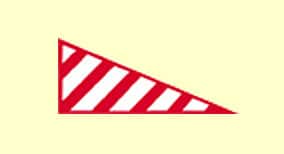Explantion: You may park across the entrance to a property only with the owner's consent.Parking across an entrance may cause inconvenience and danger to persons entering or leaving the property.
Explantion: Double parking is never permitted. Parking is never permitted where it might interfere in any way with the normal flow through traffic or obstruct or endanger other road users.
Explantion: A cycle track is for the use of cyclists and motorised wheelchairs only. No other vehicles may cross into or over a mandatory cycle track unless this is necessary in order to leave or enter a side road or a property adjacent to the cycle track.
Explantion: Parking is never permitted where it might interfere in any way with the normal flow through traffic or obstruct or endanger other road users - for example, by forcing other drivers into the path of oncoming traffic.
Explantion: Lighting up hours are defined as the period of time during which drivers should turn on dipped headlights in order to be seen. This period normally starts half an hour after sunset and ends half an hour before sunrise.
Explantion: You are legally required to stop at a level crossing when the red lights start to flash and the warning bells sound. You must wait for all barriers to open fully before proceeding.
Explantion: It is an offence to park 15 metres before or 5 metres beyond a pedestrian crossing.Parking in this manner may restrict the zone of vision of drivers approaching the crossing and endanger pedestrians.
Explantion: It is an offence to park within 5 metres of a junction unless parking spaces are clearly marked. Parking in that area may restrict the zone of vision of drivers approaching the junction and may cause an obstruction to large vehicles wishing to turn.
Explantion: It is offence to park at the side of road that has a single or double continuous white line along its centre. Parking on such a road could create an obstruction and may cause inconvenience or danger to other road users.
Explantion: A cycle track is for the use of cyclists and motorised wheelchairs. No other vehicles may cross into or over a mandatory cycle track unless this is necessary in order to leave a side road or a property adjacent to the cycle track.
Explantion: It is always an offence to park on a footpath. Where a vehicle is parked on a footpath, pedestrians may have to step onto the road to go around the vehicle and so place themselves in danger.
Explantion: Drivers need to see and be seen during all periods of low light levels - for example, at dusk and dawn and in some bad weather conditions. At times of low light, you should turn on dipped headlights. The Road Safety Authority recommends that motorcyclists and drivers turn on their dipped headlights or daytime running lights during daylight hours.
Explantion: Where there is no footpath provided, pedestrians should walk on the right-hand side of the road facing oncoming traffic. Drivers should be aware of the Rules of the Road for pedestrians, drive with caution and be prepared to react to any changes in the traffic situation.
Explantion: The law requires all motorised vehicles to display a rear number plate that is clean and legible.
Explantion: Pedestrians should walk in single file on busy narrow roads. Drivers should be aware of the Rules of the Road for pedestrians, drive with caution and be prepared to react to any changes in the traffic situation.
Explantion: Outside built-up areas, pedestrians should wear reflective clothing at all times when walking at night. This is particularly important where there is no street lighting and no footpath for pedestrians.
Explantion: Stopping or parking within an area marked as taxi rank is prohibited as this may obstruct taxis entering or leaving the rank.
Explantion: Loading bays are provided to enable goods vehicles to load or unload goods, up to a maximum of 30 minutes. Only goods vehicles are permitted to use loading bays.
Explantion: Normally you must overtake on the right. There are, however, circumstances where you may overtake on the left - for example, when the vehicle has moved out and signalled to turn right.

Explantion: This marker board is displayed on heavy goods vehicle loads to alert other road users when the load or equipment overhangs the front or rear of the vehicle by more than 2 meters.
Explantion: Parking on the brow of a hill or on a humpbacked bridge is prohibited. Parking in such a place may restrict the zone of vision of drivers approaching the hill and force them into the path of oncoming traffic.
Explantion: Rumble strips are a pattering in the surface of the roadway that causes a rumbling sound when you drive over them. The purpose of them is to warn you of a potential danger ahead or to the side.
Explantion: As road users, pedestrians must comply with traffic controls. Drivers should be aware that traffic lights and pedestrians lights can be combined at junctions and should show caution and consideration to pedestrians.
Explantion: The purpose of traffic calming measures is to slow down fast-moving traffic to a speed more suitable for the area they are entering. These measures are usually found in rural areas on the entry points to towns or villages.
Explantion: At a level crossing with unattended gates a driver must stop, look for trains and listen for the sound of a horn or approaching trains. If it is safe, open both gates, complete the crossing and then close both gates.